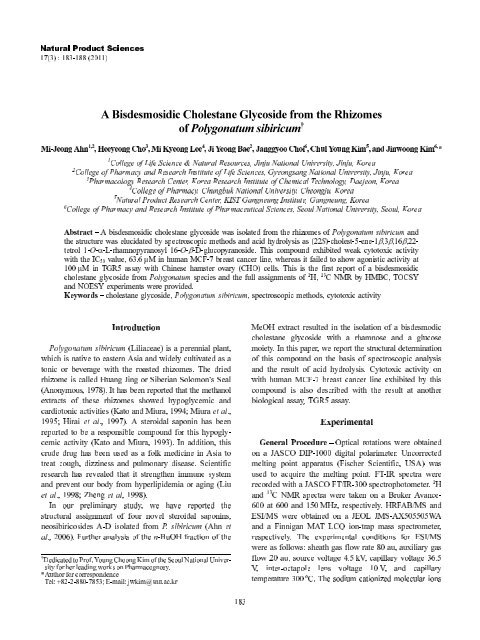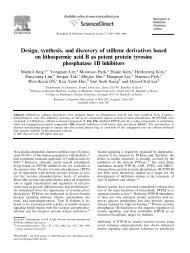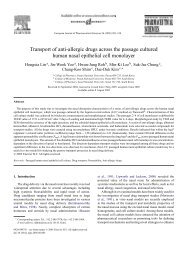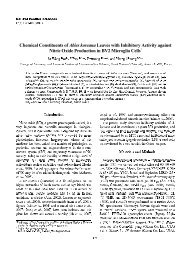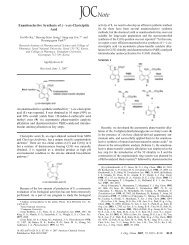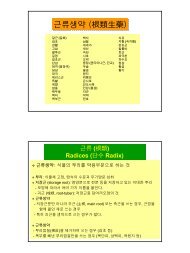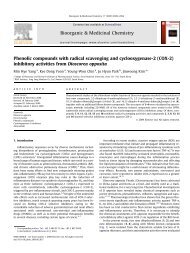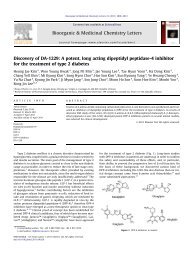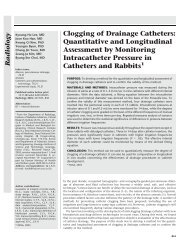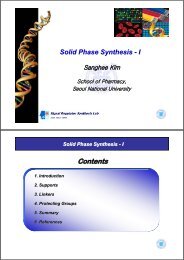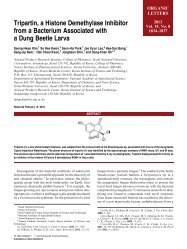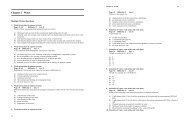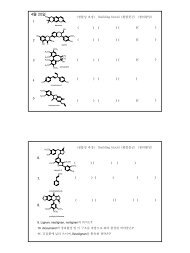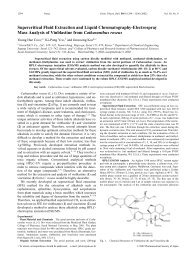A Bisdesmosidic Cholestane Glycoside from the Rhizomes of ...
A Bisdesmosidic Cholestane Glycoside from the Rhizomes of ...
A Bisdesmosidic Cholestane Glycoside from the Rhizomes of ...
Create successful ePaper yourself
Turn your PDF publications into a flip-book with our unique Google optimized e-Paper software.
Product Sciences<br />
Natural<br />
: 183-188 (2011)<br />
17(3)<br />
1<br />
<strong>of</strong> Life Science & Natural Resources, Jinju National University, Jinju, Korea<br />
College<br />
2<br />
<strong>of</strong> Pharmacy and Research Institute <strong>of</strong> Life Sciences, Gyeongsang National University, Jinju, Korea<br />
College<br />
3<br />
Research Center, Korea Research Institute <strong>of</strong> Chemical Technology, Daejeon, Korea<br />
Pharmacology<br />
4<br />
<strong>of</strong> Pharmacy, Chungbuk National University, Cheongju, Korea<br />
College<br />
5<br />
Product Research Center, KIST Gangneung Institute, Gangneung, Korea<br />
Natural<br />
6<br />
<strong>of</strong> Pharmacy and Research Institute <strong>of</strong> Pharmaceutical Sciences, Seoul National University, Seoul, Korea<br />
College<br />
− A bisdesmosidic cholestane glycoside was isolated <strong>from</strong> <strong>the</strong> rhizomes <strong>of</strong> Polygonatum sibiricum and<br />
Abstract<br />
structure was elucidated by spectroscopic methods and acid hydrolysis as (22S)-cholest-5-ene-1β,3β,16β,22-<br />
<strong>the</strong><br />
1-O-α-L-rhamnopyranosyl 16-O-β-D-glucopyranoside. This compound exhibited weak cytotoxic activity<br />
tetrol<br />
<strong>the</strong> IC 50 value, 63.6 µM in human MCF-7 breast cancer line, whereas it failed to show agonistic activity at<br />
with<br />
µM in TGR5 assay with Chinese hamster ovary (CHO) cells. This is <strong>the</strong> first report <strong>of</strong> a bisdesmosidic<br />
100<br />
glycoside <strong>from</strong> Polygonatum species and <strong>the</strong> full assignments <strong>of</strong> 1 H, 13 C NMR by HMBC, TOCSY<br />
cholestane<br />
NOESY experiments were provided.<br />
and<br />
− cholestane glycoside, Polygonatum sibiricum, spectroscopic methods, cytotoxic activity<br />
Keywords<br />
sibiricum (Liliaceae) is a perennial plant,<br />
Polygonatum<br />
is native to eastern Asia and widely cultivated as a<br />
which<br />
or beverage with <strong>the</strong> roasted rhizomes. The dried<br />
tonic<br />
is called Huang Jing or Siberian Solomon’s Seal<br />
rhizome<br />
1978). It has been reported that <strong>the</strong> methanol<br />
(Anonymous,<br />
<strong>of</strong> <strong>the</strong>se rhizomes showed hypoglycemic and<br />
extracts<br />
activities (Kato and Miura, 1994; Miura et al.,<br />
cardiotonic<br />
Hirai et al., 1997). A steroidal saponin has been<br />
1995;<br />
to be a responsible compound for this hypoglycemic<br />
reported<br />
activity (Kato and Miura, 1993). In addition, this<br />
drug has been used as a folk medicine in Asia to<br />
crude<br />
cough, dizziness and pulmonary disease. Scientific<br />
treat<br />
has revealed that it streng<strong>the</strong>n immune system<br />
research<br />
prevent our body <strong>from</strong> hyperlipidemia or aging (Liu<br />
and<br />
al., 1998; Zheng et al, 1998).<br />
et<br />
our preliminary study, we have reported <strong>the</strong><br />
In<br />
assignment <strong>of</strong> four novel steroidal saponins,<br />
structural<br />
A-D isolated <strong>from</strong> P. sibiricum (Ahn et<br />
neosibiricosides<br />
Dedicated to Pr<strong>of</strong>. Young Choong Kim <strong>of</strong> <strong>the</strong> Seoul National University<br />
† for her leading works on Pharmacognosy.<br />
for correspondence<br />
*Author<br />
+82-2-880-7853; E-mail: jwkim@snu.ac.kr<br />
Tel:<br />
extract resulted in <strong>the</strong> isolation <strong>of</strong> a bisdesmodic<br />
MeOH<br />
glycoside with a rhamnose and a glucose<br />
cholestane<br />
In this paper, we report <strong>the</strong> structural determination<br />
moiety.<br />
this compound on <strong>the</strong> basis <strong>of</strong> spectroscopic analysis<br />
<strong>of</strong><br />
<strong>the</strong> result <strong>of</strong> acid hydrolysis. Cytotoxic activity on<br />
and<br />
human MCF-7 breast cancer line exhibited by this<br />
with<br />
is also described with <strong>the</strong> result at ano<strong>the</strong>r<br />
compound<br />
assay, TGR5 assay.<br />
biological<br />
Procedure − Optical rotations were obtained<br />
General<br />
a JASCO DIP-1000 digital polarimeter. Uncorrected<br />
on<br />
point apparatus (Fischer Scientific, USA) was<br />
melting<br />
to acquire <strong>the</strong> melting point. FT-IR spectra were<br />
used<br />
with a JASCO FT/IR-300 spectrophotometer. 1 H<br />
recorded 13<br />
C NMR spectra were taken on a Bruker Avance-<br />
and<br />
at 600 and 150 MHz, respectively. HRFAB/MS and<br />
600<br />
were obtained on a JEOL JMS-AX505505WA<br />
ESI/MS<br />
a Finnigan MAT LCQ ion-trap mass spectrometer,<br />
and<br />
The experimental conditions for ESI/MS<br />
respectively.<br />
as follows: sheath gas flow rate 80 au, auxiliary gas<br />
were<br />
20 au, source voltage 4.5 kV, capillary voltage 36.5<br />
flow<br />
inter-octapole lens voltage 10 V, and capillary<br />
V,<br />
300 o C. The sodium cationized molecular ions<br />
temperature<br />
A <strong>Bisdesmosidic</strong> <strong>Cholestane</strong> <strong>Glycoside</strong> <strong>from</strong> <strong>the</strong> <strong>Rhizomes</strong><br />
<strong>of</strong> Polygonatum sibiricum †<br />
Mi-Jeong Ahn 1,2 , Heeyeong Cho 3 , Mi Kyeong Lee 4 , Ji Yeong Bae 2 , Janggyoo Choi 6 , Chul Young Kim 5 , and Jinwoong Kim 6, *<br />
Introduction<br />
Experimental<br />
al., 2006). Fur<strong>the</strong>r analysis <strong>of</strong> <strong>the</strong> n-BuOH fraction <strong>of</strong> <strong>the</strong><br />
183
isolated with an isolation width <strong>of</strong> 2 m/z units and<br />
were<br />
using a collision energy <strong>of</strong> 55% for MS 2<br />
fragmented<br />
GC was conducted on a GC353B-FSL gas<br />
experiments.<br />
(GL Sciences) with a flame ionization<br />
chromatograph<br />
(FID). TLC was carried out on silica gel precoated<br />
detector<br />
(Art. No. 5715, Merck). Silica gel 60 (40 - 63 µm,<br />
plates<br />
9385, Merck) and ODS-A YMC Gel (12 nm -<br />
Art.<br />
µm, AA12SA5, Kyoto, Japan) were used for column<br />
150<br />
All chemicals used in bioassay were <strong>of</strong><br />
chromatography.<br />
reagent grade.<br />
biochemical<br />
Material − The rhizomes <strong>of</strong> Polygonatum<br />
Plant<br />
Redouté (Liliaceae) were collected in Kyeongki<br />
sibiricum<br />
<strong>of</strong> Korea in April, 2005. This plant was<br />
province<br />
by Pr<strong>of</strong>. Jong Hee Park <strong>of</strong> <strong>the</strong> College <strong>of</strong><br />
identified<br />
Pusan National University, Korea. A voucher<br />
Pharmacy,<br />
(SNUPH-0328) is deposited in <strong>the</strong> Herbarium<br />
specimen<br />
<strong>the</strong> College <strong>of</strong> Pharmacy, Seoul National University.<br />
<strong>of</strong><br />
and Isolation − The fresh rhizomes (30 kg)<br />
Extraction<br />
P. sibiricum were extracted twice with 100% MeOH<br />
<strong>of</strong><br />
L) and evaporated in vacuo. The MeOH extract (3.8<br />
(30<br />
was dissolved in water and partitioned with n-butanol.<br />
kg)<br />
n-butanol layer (75 g) was concentrated in vacuo and<br />
The<br />
into five fractions (F.1 - F.5) on silica gel column<br />
divided<br />
(Merck, 230 - 400 mesh, 1 kg) using<br />
chromatography<br />
3 -MeOH-H 2 O mixtures <strong>of</strong> increasing polarity (30 :<br />
CHCl<br />
: 1 (F.1), 15 : 5 : 1 (F.2), 10 : 5 : 1 (F.3, F.4), 6 : 5 : 1<br />
5<br />
3 L <strong>of</strong> each). The F.4 fraction (12 g) was <strong>the</strong>n<br />
(F.5),<br />
on ODS silica gel to give five<br />
chromatographed<br />
Compound 1 (11 mg) was purified <strong>from</strong><br />
subfractions.<br />
2 by Sep-Pack cartilage (Waters C 18 , USA)<br />
subfraction<br />
crystallization in aqueous MeOH solution.<br />
and<br />
<strong>of</strong> Sugar Components <strong>of</strong> Compound 1 −<br />
Analysis<br />
acidic hydrolysis <strong>of</strong> compound 1 (1 mg) and <strong>the</strong><br />
The<br />
L-cysteine derivatization <strong>of</strong> <strong>the</strong> mono-<br />
trimethylsilyl<br />
were carried out according to <strong>the</strong> previous<br />
saccharide<br />
paper (Ahn et al., 2006). Under <strong>the</strong>se conditions,<br />
published<br />
sugars gave peaks at t R (min); 11.38 and 12.23<br />
standard<br />
D- and L-glucose, and 8.42 for L-rhamnose, respectively.<br />
for<br />
1 − amorphous powder; [α] 20 D −45.8 o (c<br />
Compound<br />
MeOH); IR (KBr) ν max 3430 (OH), 2926 (CH),<br />
0.13,<br />
1371, 1265, 1067, 824 cm −1 ; 1 H NMR and 13 C<br />
1453,<br />
see Table 1; ESIMS (positive mode) m/z 765 [M +<br />
NMR,<br />
+<br />
; HRFABMS m/z 765.4421 (calcd for C 39 H 66 O 13 Na,<br />
Na]<br />
mp: 177 - 179 o C<br />
765.4401);<br />
assay − Cytotoxic activity was evaluated<br />
Cytotoxicity<br />
MCF-7 cells according to <strong>the</strong> previous published<br />
with<br />
(Ahn et al., 2006).<br />
paper<br />
assay − Chinese hamster ovary (CHO) cells<br />
TGR5<br />
transfected with CREB-luc were obtained <strong>from</strong><br />
stably<br />
and were maintained in F12K supplemented<br />
Panomics,<br />
1. 1 H and 13 C NMR Spectral Data for Compound 1 (in<br />
Table<br />
5 D 5 N) a<br />
C<br />
4.37 dd (11.8, 4.5)<br />
6''b<br />
a<br />
for positions 26 and 27 are exchangeable each o<strong>the</strong>r.<br />
Signals<br />
10% fetal bovine serum, 100 U/mL penicillin, 100<br />
with<br />
streptomycin sulfate, and hygromycin (100 µg/<br />
µg/mL<br />
For <strong>the</strong> TGR5 assay, a stable cell line was obtained<br />
ml).<br />
transfection with TGR5 expression plasmid (pCMV6/<br />
by<br />
184 Natural Product Sciences<br />
position δ H δ C HMBC<br />
1 3.72 dd (11.5, 3.6) 81.1 H-1'<br />
2 2.78 br d, 2.47 35.7<br />
3 3.81 m 67.8 H-4<br />
4 2.64, 2.52 43.4 H-6<br />
5 138.8<br />
6 5.46 m 124.9<br />
7 1.73, 1.35 31.2 H-6<br />
8 1.25 33.2 H-6, H-15<br />
9 1.24 50.5 H-1, H-19<br />
10 42.6 H-1, H-6, H-9, H-11, H-19<br />
11 2.58, 1.55 24.6<br />
12 2.05, 1.45 40.3 H-17, H-18<br />
13 42.0<br />
14 0.84 55.0<br />
15 2.28, 1.74 36.9<br />
16 4.50 82.3 H-1''<br />
17 1.96 dd (10.8, 7.6) 57.8 H-14, H-15, H-18, H-21<br />
18 0.97 s 13.6 H-12, H-17<br />
19 1.14 s 14.3 H-1<br />
20 1.85 35.6 H-17, H-21<br />
21 1.12 d (7.2) 12.3<br />
22 4.29 72.8<br />
23 1.83, 1.77 33.7<br />
24 1.89, 1.59 36.4 H-25, H-26, H-27<br />
25 1.58 28.7 H-24, H-26, H-27<br />
26 0.85 22.8 H-25<br />
27 0.86 22.9 H-25<br />
1' 5.60 (br s) 97.5 H-1<br />
2' 4.49 dd (br d) 72.7 H-1'<br />
3' 4.44 dd (7.6) 72.6 H-1'<br />
4' 4.25 dd 73.3<br />
5' 4.22 m 70.4 H-1', H-4', H-6'<br />
6' 1.60 d (6.1) 18.5 H-5'<br />
1'' 4.71 d (7.2) 106.7<br />
2'' 3.97 dd (7.7, 7.2) 75.3 H-1''<br />
3'' 4.13 dd (7.7, 7.5) 78.5 H-1''<br />
4'' 4.23 dd (7.5, 7.3) 71.3<br />
5'' 3.80 m 77.9 H-1''<br />
6''a 4.47 br d 62.5 H-4'', H-5''
Fig. 1. Chemical structure <strong>of</strong> compound 1.<br />
Origene) using Lip<strong>of</strong>ectamine 2000 reagent<br />
TGR5,<br />
The transfected cells were selected with 600<br />
(Invitrogen).<br />
G418 sulfate, and single clones were grown in a<br />
µg/mL<br />
plate, independently. Samples were tested by<br />
96-well<br />
on <strong>the</strong> selected CHO/CREB-luc/TGR5 cell<br />
luminescence<br />
The biological effects <strong>of</strong> samples on TGR5 were<br />
line.<br />
to those <strong>of</strong> lithocholic acid (Sigma, USA) used<br />
compared<br />
an internal control in <strong>the</strong> luciferase assay. TGR5-<br />
as<br />
CHO cells were treated for 5 h with 10 µM<br />
expressing<br />
acid or 100 µM sample, followed by a<br />
lithocholic<br />
assay. Luminescence was determined with<br />
luciferase<br />
alpha (PerkinElmer).<br />
Fusion<br />
concentrated MeOH extract <strong>of</strong> <strong>the</strong> rhizomes <strong>of</strong> P.<br />
The<br />
was partitioned between n-BuOH and water.<br />
sibiricum<br />
n-BuOH-soluble fraction was chromatographed on Si<br />
The<br />
octadecylsilanized (ODS) Si gel to give compound 1<br />
gel,<br />
1). (Fig.<br />
1, obtained as an amorphous powder,<br />
Compound<br />
a positive dark-green color by Lieberman-Burchard<br />
showed<br />
on TLC plate. In <strong>the</strong> positive-ion ESIMS <strong>of</strong> 1, a<br />
reagent<br />
quasimolecular ion peak at m/z 765 [M + Na] +<br />
and HRFABMS analysis revealed <strong>the</strong> molecular<br />
observed,<br />
to be C 39 H 66 O 13 .<br />
formula<br />
1 H-NMR spectrum <strong>of</strong> 1 showed signals for two<br />
The<br />
methyl groups at δ 0.97 and 1.14 (each 3H, s),<br />
tertiary<br />
at δ 1.60 (d, J = 6.1 Hz) was due to <strong>the</strong> methyl<br />
signal<br />
<strong>of</strong> 6-deoxyhexopyranose. Two anomeric proton<br />
group<br />
were also found at δ 5.60 (br s) and 4.71 (d,<br />
signals<br />
= 7.2 Hz). From <strong>the</strong> 13 C NMR spectrum showing 39<br />
J<br />
lines, 27 <strong>of</strong> <strong>the</strong>m were attributed to aglycone part<br />
resonance<br />
12 to two monosaccharides. These NMR data supported<br />
and<br />
fact that 1 has a steroidal skeleton and two saccharide<br />
<strong>the</strong><br />
All <strong>the</strong> carbon signals <strong>of</strong> its aglycone were<br />
moieties.<br />
with those <strong>of</strong> previously reported (22S)-cholest-5-<br />
consistent<br />
moiety (Mimaki et al., 1999).<br />
ene-1β,3β,16β,22-tetrol<br />
2. GC chromatogram <strong>of</strong> acid hydrolysate (trimethylsilyl L-<br />
Fig.<br />
derivatives) <strong>of</strong> compound 1. Two major peaks indicate<br />
cysteine<br />
monosaccharides obtained <strong>from</strong> <strong>the</strong> acidic hydrolysis<br />
The<br />
1 were identified as D-glucose and L-rhamnose with<br />
<strong>of</strong><br />
molar ratio <strong>of</strong> 1 : 1 by GC <strong>of</strong> <strong>the</strong>ir respective<br />
<strong>the</strong><br />
L-cysteine derivatives (Fig. 4) (Agrawal et<br />
trimethylsilyl<br />
1985; Hara et al., 1987). The β-orientations <strong>of</strong> <strong>the</strong><br />
al.,<br />
moiety was supported by <strong>the</strong> relatively large J<br />
glucose<br />
<strong>of</strong> <strong>the</strong> anomeric proton (J = 7.2 Hz for H-1'') and<br />
values<br />
chemical shift (δ 106.7) <strong>of</strong> <strong>the</strong> anomeric carbon. The<br />
<strong>the</strong><br />
<strong>of</strong> <strong>the</strong> L-rhamnose was confirmed by<br />
α-configuration 13<br />
C shifts because remarkable differences in <strong>the</strong> 13 C<br />
<strong>the</strong>ir<br />
at C-3 and C-5 were recognized between α-, and β-<br />
shifts<br />
(Agrawal et al., 1985; Agrawal et<br />
L-rhamnopyranosides<br />
1992). al.,<br />
monosaccharide was considered to be directly<br />
Each<br />
to <strong>the</strong> aglycone and was not substituted because<br />
attached<br />
glycosylation shifts could be observed among <strong>the</strong><br />
no<br />
13 C NMR shifts (Mimaki et al., 2000). This fact<br />
assigned<br />
revealed by <strong>the</strong> following correlations in <strong>the</strong> HMBC<br />
was<br />
(Fig. 3). The H-1 proton (δ 3.72) <strong>of</strong> <strong>the</strong><br />
spectrum<br />
and <strong>the</strong> anomeric proton (δ 4.71) <strong>of</strong> glucose<br />
aglycone<br />
correlations with <strong>the</strong> anomeric carbon <strong>of</strong><br />
showed<br />
(δ 97.5) and <strong>the</strong> C-16 carbon (δ 82.3) <strong>of</strong> <strong>the</strong><br />
rhamnose<br />
respectively. These correlations were also<br />
aglycone,<br />
by NOESY spectrum and anomeric carbon<br />
confirmed<br />
(δ 97.5 and 106.7 for rhamnose and glucose,<br />
signals<br />
different <strong>from</strong> those (δ 104.9 and 101.3) <strong>of</strong><br />
respectively)<br />
1-O-β-D-gluco-<br />
16-O-α-L-rhamnopyranoside. 1D-selective TOCSY<br />
pyranosyl<br />
allowed <strong>the</strong> sequential assignments <strong>of</strong> all<br />
experiment<br />
for each monosaccharide, starting <strong>from</strong> <strong>the</strong><br />
resonances<br />
protons (Fig. 4).<br />
anomeric<br />
Vol. 17, No. 3, 2011 185<br />
L-rhamnose (A) and D-glucose (B), respectively.<br />
Fig. 3. HMBC correlations <strong>of</strong> compound 1.<br />
Results and Discussion<br />
was<br />
secondary methyl groups at δ 1.12 (d, J = 7.2 Hz), δ<br />
three<br />
and 0.86, and an olefinic proton at δ 5.46 (m). The<br />
0.85<br />
(22S)-cholest-5-ene-1β,3β,16β,22-tetrol
Fig. 4. 1 H-NMR spectrum (A) and δ 4.75 selective TOCSY spectrum (B) <strong>of</strong> compound 1 (600 MHz, in C 5 D 5 N).<br />
compound 1 displayed a quasimolecular<br />
Meanwhile,<br />
peak at m/z 765 [M + Na] + and m/z 781 [M + K] + .<br />
ion<br />
The MS/MS spectrum <strong>of</strong> <strong>the</strong> [M + Na] +<br />
<strong>of</strong> a hydroxy group (18 Da) in aglycone moiety, a<br />
loss<br />
unit (146 Da) and a glucose unit (162 Da),<br />
rhamnose<br />
In addition, it exhibited <strong>the</strong> peaks at m/z 403<br />
respectively.<br />
+ Na − Glc − Rhm − 3H 2 O] + due to <strong>the</strong> successive<br />
[M<br />
<strong>of</strong> two saccharide moieties and three hydroxy groups.<br />
loss<br />
peaks at m/z 695 [M + Na − C 5 H 10 ] +<br />
resulted <strong>from</strong><br />
The<br />
cleavage <strong>of</strong> side chain <strong>of</strong> <strong>the</strong> aglycone (Fig. 5).<br />
<strong>the</strong><br />
<strong>the</strong> basis <strong>of</strong> <strong>the</strong> obtained data, <strong>the</strong> structure <strong>of</strong><br />
On<br />
1 was assigned as (22S)-cholest-5-ene-<br />
compound<br />
1-O-α-L-rhamnopyranosyl 16-O-β-<br />
1β,3β,16β,22-tetrol<br />
(Mimaki et al., 1999). This compound<br />
D-glucopyranoside<br />
to rare cholestane bisdesmosides possessing<br />
belongs<br />
residues linked to a polyhydroxycholesterol<br />
disaccharide<br />
<strong>Bisdesmosidic</strong> cholestane glycosides have been<br />
aglycone.<br />
<strong>from</strong> several Liliaceae plants. Since compound 1<br />
isolated<br />
firstly isolated <strong>from</strong> a plant source, Allium jesdianum,<br />
was<br />
has been reported to be isolated <strong>from</strong> tubers or bulbs or<br />
it<br />
<strong>of</strong> Liliaceae plants (Dai et al., 2000; Fattorusso et al.,<br />
seed<br />
Sang et al., 2000; Higano et al., 2007). Partial<br />
2000;<br />
or overlapped signals in CD 3 OD has been<br />
assignment<br />
reported (Fattorusso et al., 2000). However,<br />
previously<br />
is <strong>the</strong> first report <strong>of</strong> a bisdesmodic cholestane<br />
this<br />
<strong>from</strong> <strong>the</strong> genus Polygonatum. In this study, <strong>the</strong><br />
glycoside<br />
assignment <strong>of</strong> 1 H-NMR spectrum by HSQC, TOCSY<br />
full<br />
NOESY experiments was also provided.<br />
and<br />
compound 1 was reported not to have shown<br />
Although<br />
activity against HL-60 cells, this compound<br />
cytotoxic<br />
weak cytotoxic activity with <strong>the</strong> IC 50 value, 63.6<br />
exhibited<br />
in human MCF-7 breast cancer line (Mimaki et al.,<br />
µM<br />
Meanwhile, TGR5 is an emerging bile acid G-<br />
1999).<br />
receptor target for <strong>the</strong> potential treatment<br />
protein-coupled<br />
metabolic disorders or inflammation (Atul and Pranab,<br />
<strong>of</strong><br />
186 Natural Product Sciences<br />
ion showed <strong>the</strong><br />
at m/z 747 [M + Na − H 2 O] + , 601 [M + Na − Rhm −<br />
peaks<br />
2 O] + and 585 [M + Na − Glc − H 2 O] + resulting <strong>from</strong><br />
H<br />
2009; Thijs et al., 2011). For example, TGR5 activation
Fig. 5. ESI MS spectrum <strong>of</strong> <strong>the</strong> sodium cationized compound 1 (A) and MS/MS spectrum <strong>of</strong> <strong>the</strong> molecular ion at m/z 765 (B-D).<br />
a significant reduction <strong>of</strong> <strong>the</strong> body weight <strong>of</strong> mice<br />
induces<br />
a high fat diet (Watanabe, 2006). Since compound 1<br />
fed<br />
<strong>the</strong> same cholestane structure with bile acids, ligands<br />
has<br />
this receptor, TGR5 assay was accomplished with this<br />
for<br />
using Chinese hamster ovary (CHO) cells and a<br />
isolate<br />
acid, lithocholic acid as a positive control. However,<br />
bile<br />
compound failed to show agonistic activity on TGR5<br />
this<br />
It was suggested that it could have resulted <strong>from</strong><br />
receptor.<br />
<strong>of</strong> negatively charged functional groups or presence<br />
lack<br />
a double bond to increase molecular rigidity or bulky<br />
<strong>of</strong><br />
moieties <strong>of</strong> this bisdesmosidic cholestane<br />
saccharide<br />
(Atul and Pranab, 2009).<br />
glycoside<br />
work was supported by 2010 Jinju National<br />
This<br />
Industry Academic Cooperation Foundation<br />
University<br />
Dictionary <strong>of</strong> Chinese Medicinal Materials, Shanghai<br />
Anonymous,<br />
and Technological Press, Shanghai, Vol. 2, pp. 2041-2044,<br />
Scientific<br />
1978.<br />
P.K., Jain, D.C., Gupta, R.K., and Thakur, R.S., Carbon-13<br />
Agrawal,<br />
spectroscopy <strong>of</strong> steroidal sapogenins and steroidal saponins.<br />
NMR<br />
24, 2479-2496 (1985).<br />
Phytochemistry<br />
P.K., NMR Spectroscopy in <strong>the</strong> structural elucidation <strong>of</strong><br />
Agrawal,<br />
and glycosides. Phytochemistry 31, 3307-3330<br />
oligosaccharides<br />
(1992).<br />
M.-J., Kim, C.Y., Yoon, K.D., Ryu, M.Y., Cheong, J.H., Chin, Y.W.,<br />
Ahn,<br />
Kim, J., Steroidal Saponins <strong>from</strong> <strong>the</strong> <strong>Rhizomes</strong> <strong>of</strong> Polygonatum<br />
and<br />
J. Nat. Prod. 69, 360-364 (2006).<br />
sibiricum.<br />
Tiwari. and Pranab, Maiti., TGR5: an emerging bile acid G-proteincoupled<br />
Atul,<br />
receptor target for <strong>the</strong> potential treatment <strong>of</strong> metabolic<br />
Drug Discov. Today 14, 523-530 (2009).<br />
disorders.<br />
H., Zhou, J., Deng, S., and Tan, N., <strong>Glycoside</strong>s <strong>from</strong> Ophiopogon<br />
Dai,<br />
Tianran Chanwu Yanjiu Yu Kaifa 12, 5-7 (2000).<br />
japonicas.<br />
E., Lanzotti, V., Taglialatela-Scafati, O., Rosa, M.D., and<br />
Fattorusso,<br />
A., Cytotoxic saponins <strong>from</strong> bulbs <strong>of</strong> Allium porrum L. J.<br />
Ianaro,<br />
Food Chem. 48, 3455-3462 (2000).<br />
Agric.<br />
Vol. 17, No. 3, 2011 187<br />
References<br />
Acknowledgment<br />
Grant.<br />
Hara, S., Okabe, H., and Mihashi, K., Gas-Liquid Chromatographic
<strong>of</strong> Aldose Enantiomers as Trimethylsilyl E<strong>the</strong>rs <strong>of</strong> Methyl<br />
Separation<br />
Chem. Pharm.<br />
2-(Polyhydroxyalkyl)-thiazolidine-4(R)-carboxylates.<br />
35, 501-507 (1987).<br />
Bull.<br />
T., Kuroda, M., Sakagami, H., and Mimaki, Y., Convallasaponin<br />
Higano,<br />
a new 5-spirostanol triglycoside <strong>from</strong> <strong>the</strong> rhizomes <strong>of</strong> Convallaria<br />
A,<br />
Chem. Pharm. Bull. 55, 337-339 (2007).<br />
majalis.<br />
N., Miura, T., Moriyasu, M., Ichimaru, M., Nishiyama, Y., Ogura,<br />
Hirai,<br />
and Kato, A., Cardiotonic activity <strong>of</strong> <strong>the</strong> rhizome <strong>of</strong> Polygonatum<br />
K.,<br />
in rats. Biol. Pharm. Bull. 20, 1271-1273 (1997).<br />
sibiricum<br />
A. and Miura, T., Hypoglycemic action <strong>of</strong> <strong>the</strong> rhizomes <strong>of</strong><br />
Kato,<br />
<strong>of</strong>ficinale in normal and diabetic mice. Planta Med., 60,<br />
Polygonatum<br />
(1994).<br />
201-203<br />
A. and Miura, T., Hypoglycemic activity <strong>of</strong> Polygonati rhizome in<br />
Kato,<br />
and diabetic mice. Biol. Pharm. Bull. 16, 1118-1120 (1993).<br />
normal<br />
Y.P., Fu, G.F., and Cui, H., Current advances on pharmacological<br />
Liu,<br />
<strong>of</strong> Huang Jing, Yu Zhu and <strong>the</strong>ir preparations. Li Shizhen<br />
researches<br />
and Materia Medica Research 4, 371-373 (1998).<br />
Medicine<br />
Y., Kuroda, M., Fukasawa, T., and Sashida, Y., Steroidal<br />
Mimaki,<br />
<strong>from</strong> <strong>the</strong> Bulbs <strong>of</strong> Allium jesdianum. J. Nat. Prod. 62, 194-<br />
<strong>Glycoside</strong>s<br />
(1999).<br />
197<br />
Y., Yokosuka, A., and Sashida, Y., Steroidal glycosides <strong>from</strong> <strong>the</strong><br />
Mimaki,<br />
parts <strong>of</strong> Polian<strong>the</strong>s tuberose. J. Nat. Prod. 63, 1519-1523<br />
aerial<br />
T., Kato, A., Usami, M., Kadowaki, S., and Seino, Y., Effect <strong>of</strong><br />
Miura,<br />
rhizome on blood glucose and facilitative glucose<br />
polygonati<br />
is<strong>of</strong>orm 2 (GLUT2) mRNA expression in Wistar fatty rats.<br />
transporter<br />
Pharm. Bull. 18, 624-625 (1995).<br />
Biol.<br />
T.W.H., Lilia, G.N., Nomura, M., Auwerxa, J., and Schoonjans, K.,<br />
Pols,<br />
bile acid membrane receptor TGR5 as an emerging target in<br />
The<br />
and inflammation. J. Hepatol. 54, 1263-1272 (2011).<br />
metabolism<br />
S., Xia, Z., Mao, S., Lao, A., and Chen, Z., Studies on chemical<br />
Sang,<br />
in seed <strong>of</strong> Allium tuberosum Rottl. Zhongguo Zhongyao<br />
constituents<br />
25, 286-288 (2000).<br />
Zazhi<br />
M., Houten, S.M., Mataki, C., Christ<strong>of</strong>folete, M.A., Kim,<br />
Watanabe,<br />
Sato, H., Messaddeq, N., Harney, J.W., Ezaki, O., Kodama, T.,<br />
B.W.,<br />
K., Bianco, A.C., and Auwerx, J., Bile acids induce<br />
Schoonjans,<br />
expenditure by promoting intracellular thyroid hormone<br />
energy<br />
Nature 439, 484-489 (2006).<br />
activation.<br />
H.Z., Dong, Z.H., and She, J., Modernization <strong>of</strong> Traditional<br />
Zheng,<br />
Medicine and Application, Xueyuan Press, Beijing, pp. 4071-<br />
Chinese<br />
1998.<br />
4074,<br />
July 20, 2011<br />
Received<br />
August 17, 2011<br />
Revised<br />
188 Natural Product Sciences<br />
Accepted August 20, 2011<br />
(2000).


